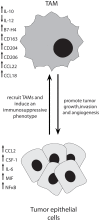Tumor-associated macrophages contribute to tumor progression in ovarian cancer
- PMID: 24936477
- PMCID: PMC4047518
- DOI: 10.3389/fonc.2014.00137
Tumor-associated macrophages contribute to tumor progression in ovarian cancer
Abstract
Ovarian cancer is the leading cause of death in women with gynecological malignancy and improvements in current treatments are needed. As with many other solid cancers, the ovarian tumor microenvironment is emerging as a key player in tumor progression and a potential therapeutic target. The tumor microenvironment contains several non-malignant cell types that are known to contribute to tumor progression and metastasis. Included in this population of non-malignant cells are several different types of immune cells, of which tumor-associated macrophages (TAMs) are the most abundant. An increasing amount of evidence is emerging to suggest that TAMs display a unique activation profile in ovarian tumors and are able to create an immunosuppressive microenvironment, allowing tumors to evade immune detection and promoting tumor progression. Therefore, an increased understanding of how these immune cells interact with tumor cells and the microenvironment will greatly benefit the development of more effective immunotherapies to treat ovarian cancer. This review focuses on the role of TAMs in the ovarian tumor microenvironment and how they promote tumor progression.
Keywords: macrophages in ovarian cancer; ovarian cancer; tumor microenvironment; tumor-associated macrophages.
Figures
References
-
- Morgan RJ, Jr, Alvarez RD, Armstrong DK, Boston B, Chen LM, Copeland L, et al. Ovarian cancer. Clinical practice guidelines in oncology. J Natl Compr Canc Netw (2008) 6(8):766–94 - PubMed
Publication types
LinkOut - more resources
Full Text Sources
Other Literature Sources
Research Materials


